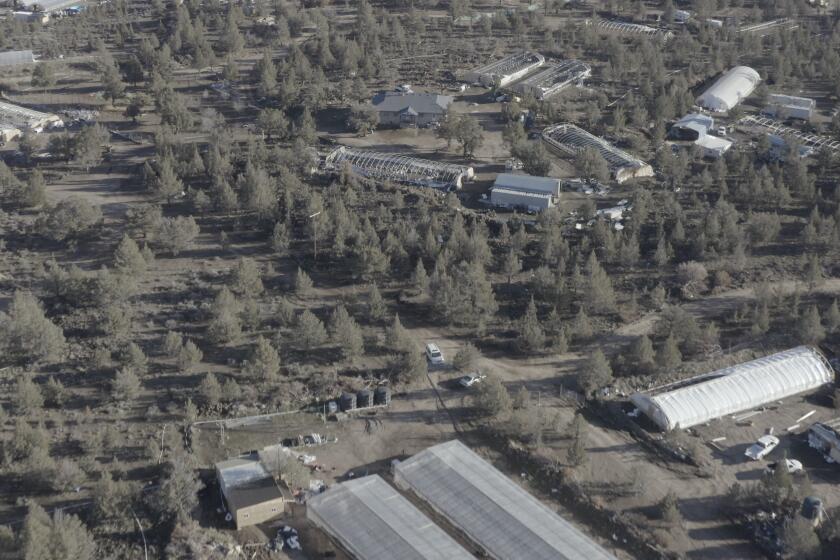California hails $544 million in illegal weed seizures. But it’s just a drop in the bucket

- Share via
- “From the criminal mindset, there is minimal downside and massive upside to cultivating marijuana illegally,” says one sheriff’s official.
Two major state programs to combat illegal cannabis recently sent out news releases lauding their collective seizures of some $544 million worth of illicit weed.
But when it comes to reining in California’s sprawling black market, experts say it’s just a drop in the bucket.
Those in the thick of the fight against illegal pot, like Mendocino County Sheriff Matthew Kendall, can’t help but roll their eyes.
“Don’t get me wrong, I love when those guys [state law enforcement officers] show up to help,” he said, “but I would need 50 police officers for 50 days to even begin putting a dent in it.”

So far this year, an estimated $353 million worth of illicit plants have been seized through a California Department of Justice program, while a task force with the governor’s office has seized an estimated $191 million.
Despite these alarming numbers, some law enforcement leaders say the raids are barely slowing the black market — which, according to a study by Beau Whitney, founder of cannabis economics research firm Whitney Economics, makes up more than half the state’s marijuana sales.
“If we examine the statistics, it is clear that these operations are not effectively or aggressively putting a dent into the illegal market,” said Siskiyou County Sheriff Jeremiah LaRue.
For the record:
3:07 p.m. Oct. 28, 2024An earlier version of this article said EPIC seized about 77,000 plants. It was 750,000.
For example, operations by the state Department of Justice’s Eradication and Prevention of Illicit Cannabis program, or EPIC, have seized about 750,000 cannabis plants in 36 counties this year. Yet, Siskiyou County alone produces an estimated 12 million to 16 million illegal plants per year. Therefore, if EPIC only focused on Siskiyou for a year, it would eradicate just 6% of the estimated local black market, he said.

A member of a Siskiyou County sheriff’s task force drags cannabis plants out of a greenhouse for burial during a Mount Shasta Vista raid.
This sentiment was echoed by Kendall, who noted that in Mendocino County’s 35-square-mile Round Valley alone there are an estimated 1 million illegal marijuana plants.
“The black market is as big and bad as ever,” he said.
The Riverside County Sheriff’s Department marijuana enforcement team told The Times there is still a lot of work to do to address that county’s black market, which has not gotten any smaller in the last two years.
In 2022, a Times investigation found that California’s massive illegal marijuana market pushes legal growers toward financial ruin, exacerbates community violence, causes massive amounts of environmental degradation and forces laborers to toil in squalid and often dangerous conditions.
Illegal cannabis farms are engulfing parts of California and exploiting farmworkers who labor in squalid, deadly conditions, a Times investigation finds.
Since then, many law enforcement leaders say they believe the state has done little to address the problems fueling the black market — onerous taxation and regulations for legal producers, few consequences for illegal operators and limited access to legal marijuana in wide swaths of California.
“It’s like [state leaders] came to our counties, they sprayed the whole thing with gasoline and lit it on fire,” Kendall said. “Then they start talking about EPIC doing this work that is basically showing up with a garden hose.”
A spokesperson for the Department of Cannabis Control said the department was acutely aware of the economic pressures facing the legal market and understood that enforcement without policy reform could not equalize the playing field. The spokesperson pointed to Gov. Gavin Newsom’s recent comments urging policymakers to prioritize solutions that remove burdens from the legal market, address competition from unregulated sources and improve access to regulated products.
“DCC looks forward to continued partnership with policymakers as they respond to this call and develop policies that aim to tackle the challenges that are inherent to transitioning an unregulated market to a regulated space,” said a department spokesperson in a statement.
California legalized recreational weed through Proposition 64, a 2016 ballot measure that promised “to tax the growth and sale of marijuana in a way that drives out the illicit market.” Eight years later, the illicit market continues to thrive.
“California did a horrible job of incentivizing [illegal] cultivators to convert over,” said Whitney, the cannabis economist. “They taxed them heavily, they regulated them heavily, they couldn’t make any money.”
California charges a 15% excise tax on marijuana sales on top of additional local marijuana taxes. A recent study by cannabis industry research and analysis firm GreenWave Advisors found that legal weed companies owe the state more than $730 million in back taxes, 72% of which is owed by companies that have gone out of business.

Another challenge is that more than half of California counties don’t allow the sale of marijuana, which restricts access to legal weed in wide swaths of the state and drives demand to the black market.
There are also major incentives for sellers to opt into the illegal market — they can dodge taxation and licensing fees, while knowing that the penalty for selling or transportation of marijuana without required licenses is only a misdemeanor.
“From the criminal mindset, there is minimal downside and massive upside to cultivating marijuana illegally and selling it on the black market,” said San Bernardino County Sheriff’s Lt. Larry Lopez.
Siskiyou County Sheriff LaRue said that, although there are enhanced penalties for certain violations involving tax evasion and environmental crimes, most of the illegal-cultivation offenses do not have harsh enough penalties to deter production.
Because enforcement measures are limited, Mendocino County Sheriff Kendall said the raids conducted by state agencies are like a game of Whac-A-Mole.
“We can chop it down and, by golly, it pops up again the next day,” he said.

Raids are also a limited enforcement tool, because they mostly lead to the arrest of laborers — not owners.
“It is a frequent strategy for the black-market organizers to hide behind the labor force and remain shielded from law enforcement,” LaRue said. “It is rare that higher-level organizers are anywhere near the cultivation areas.”
Despite the drawbacks and frustrations, Sheriffs LaRue and Kendall and Lt. Lopez still support conducting raids and welcome state assistance.
But they say that, to have a meaningful effect, raids need to be accompanied by policy changes that address the narrow profit margin for legal cultivators and the minor penalties for illegal ones.
And after years of begging for change, there’s a growing sense of exasperation among those on the front lines, even as the governor calls on policymakers to develop solutions.
Kendall said that if the problem is ever going to be fixed “the architects of these laws — the governor, the legislators” must heed what’s being said by “the carpenters, and that’s the sheriffs and the police chiefs.”
More to Read
Sign up for Essential California
The most important California stories and recommendations in your inbox every morning.
You may occasionally receive promotional content from the Los Angeles Times.












